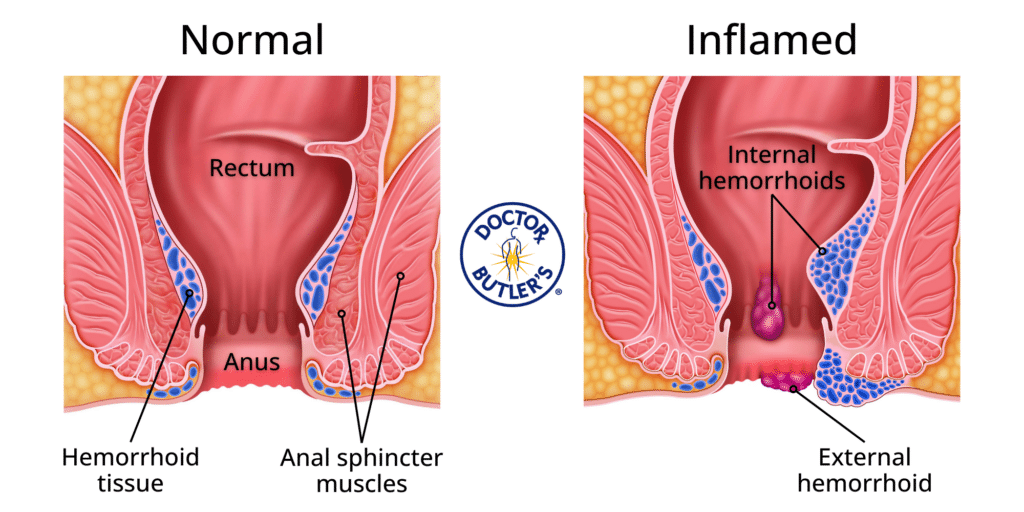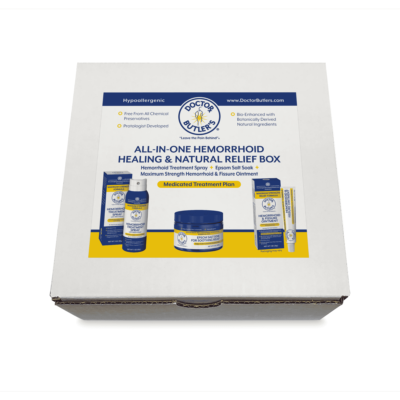Hemorrhoids are a common health concern affecting millions of people worldwide[1]. While often uncomfortable, many individuals are unsure about what constitutes normal bleeding from hemorrhoids. This comprehensive guide will help you understand hemorrhoid bleeding, its causes, and when to seek medical attention.
Table of Contents
- Understanding Hemorrhoids A Quick Overview?
- Common Causes of Hemorrhoid Bleeding
- Normal Hemorrhoid Bleeding: What to Expect
- Duration of Hemorrhoid Bleeding: What’s Typical?
- Managing Bleeding Hemorrhoids: Effective Strategies
- When to Seek Medical Help for Hemorrhoid Bleeding
- Learn More About Hemorrhoid Treatments from Doctor Butler’s
Who are we? We’re Doctor Butler’s, experts in down-there care of hemorrhoids and related conditions. We make proctologist-developed hemorrhoid ointments and complementary products to help you quickly leave the pain behind. Everything here is medically reviewed by proctologist Dr. Robert Cutler
Understanding Hemorrhoids: A Quick Overview
Hemorrhoids are swollen blood vessels in the lower rectum and near the anus that can become enlarged, causing a number of symptoms including itching, irritation and pain. There are two forms of hemorrhoids, internal and external, with each presenting a slightly different range of symptoms.

Internal hemorrhoids generally remain painless unless they push through the anal opening, becoming a prolapsed hemorrhoid. External hemorrhoids form on the anal opening and are typically to blame for the discomfort commonly associated with hemorrhoids. When blood pools within an external hemorrhoid it forms a clot, also called a thrombosed hemorrhoid.
Internal hemorrhoids are located inside the rectum and are usually painless, while external hemorrhoids develop under the skin around the anus and can be more painful and noticeable.
For a more detailed explanation of hemorrhoids and the differences between internal and external types, visit our comprehensive hemorrhoid guide.
Additional Resources About Hemorrhoids
- What Are Hemorrhoids?
- External Vs Internal Hemorrhoids: What’s the Difference?
- What Causes Hemorrhoids?
- Can Hemorrhoids Pop?
Find answers to these questions and more in our Frequently Asked Questions section.
Common Causes of Hemorrhoid Bleeding
Hemorrhoids often bleed for the same reasons that they became irritated in the first place. Bleeding is a sign that damage has occurred to the hemorrhoid wall, a potential result of the following situations:
- After a bowel movement
- When lifting heavy objects
- During diarrhea and/or constipation
- After sitting for a long time
- Straining during bowel movements
- Pregnancy and childbirth
- Obesity
- Lack of fiber in diet
Bleeding caused by hemorrhoids is not typically a reason for alarm, though the level of pain will vary based on the type of hemorrhoid behind the bleeding. A light amount of blood when wiping or a few drops in the water after using the toilet should not generate pain beyond the mild discomfort associated with concurrent symptoms such as irritation and itching.
If you have a thrombosed hemorrhoid, however, it can be quite a bit more painful. Thrombosed hemorrhoids form when blood pools within the hemorrhoid, creating a painful clot and obstructing the flow of blood within the vein. These painful lumps appear near the anal canal and unlike non-thrombosed hemorrhoids, pose the threat of rupture.
Increased stress or pressure on the surrounding tissue is what prompts the thrombosed hemorrhoid to burst, breaking through the skin and causing blood to leak out. Prior to bursting, a thrombosed hemorrhoid will produce a hard lump that can bleed if strained and cause persistent, noticeable pain, as well as irritate the surrounding area of skin.
What happens when a thrombosed hemorrhoid bursts? Rectal bleeding may occur, indicated by what can appear to be significant, continuous blood loss (enough to turn the toilet bowl red) or the passage of large clots of blood. You should seek medical attention if you experience any of the symptoms associated with a burst hemorrhoid.
Normal Hemorrhoid Bleeding: What to Expect
As we have emphasized, light bleeding is a very normal occurrence for hemorrhoid sufferers. Light refers to both the shade of the blood itself, which should be a fresh, vibrant red, as well as the quantity of blood you should be finding when wiping or dotting the toilet water after straining to pass or passing a hard stool.
Typical characteristics of normal hemorrhoid bleeding include:
- Bright red blood on toilet paper after wiping
- A few drops of blood in the toilet bowl
- Blood on the surface of the stool
- Painless bleeding during bowel movements
Heavy bleeding or dark blood are both strong indicators that you may be experiencing a more severe condition than hemorrhoids, including ulcers, inflammatory bowel disease (IBD) as well as several other disorders. Incidence of either symptom means you should be checked out by a medical professional at once.
Heavy bleeding is a consistent flow (vs. spotting), and dark blood is blood that looks maroon to dark red in color and can again show up when you wipe, in large enough quantity to turn the toilet bowl red, or as bloody stool. A black or tar-like appearance is a condition called melena that indicates damage to the upper GI lining unrelated to hemorrhoids.
Duration of Hemorrhoid Bleeding: What’s Typical?
Regardless of the cause, when hemorrhoids are bleeding, it shouldn’t ever be a long-term issue. When non-thrombosed hemorrhoids begin to bleed, they can be addressed using a number of different over-the-counter treatment options and should subside within a week as the symptoms are relieved and the hemorrhoid retreats.
Once a hemorrhoid is irritated to the point of bleeding, there is a chance the bleeding may return sporadically between bowel movements even once the bleeding has subsided. If you continue to notice blood after a week of adherence to at-home treatments or the blood increases at any point, you may be dealing with more than a hemorrhoid.
For thrombosed or prolapsed hemorrhoids, which have the potential to rupture, consistent bleeding will occur if the hemorrhoid bursts. This should last anywhere from a few seconds to a few minutes and should never exceed ten minutes. If the bleeding from a burst hemorrhoid lasts in excess of ten minutes, a physician should be contacted immediately.
It’s important to note that while occasional bleeding is common with hemorrhoids, persistent or heavy bleeding is not normal and requires medical attention.
Managing Bleeding Hemorrhoids: Effective Strategies
There are plenty of courses of action to take if your hemorrhoids start bleeding, whether they’re internal, external, thrombosed or prolapsed. These remedies help to provide immediate relief of bleeding and concurrent symptoms to long-term measures and care that promotes a healthier digestive system and improved skin conditions near the anus. Keep reading to learn about these strategies for tackling bleeding hemorrhoids.
Soothing Relief: The Benefits of Sitz Baths
Once you have noticed that your hemorrhoid is bleeding, a sitz bath is an immediate treatment option. A sitz bath is simple: fill a bath or tub with warm water, completely submerge your anal area and soak for fifteen to twenty minutes, pat dry your buttocks and perineal area with a clean towel. Taking a sitz bath is the recommended treatment for a burst hemorrhoid, as it both soothes and cleanses the affected area. Making sure a burst hemorrhoid stays free of infection is important as it heals, and a sitz bath also works to stimulate blood flow, speeding up overall healing.
Best on the market
I’ve been using this product for ages and it’s still the best thing for hemorrhoids. Works very very fast for relief.
Verified ReviewerTopical Treatments: Choosing the Right Hemorrhoid Ointment
Whether you choose a sitz bath or simply use a cold compress to stop the bleeding, once the bleeding from your burst hemorrhoid has subsided, there are different hemorrhoid ointment options that can be applied for the relief of those uncomfortable symptoms. Different ingredients are used to block or reduce the pain associated with symptoms both before and after a hemorrhoid bursts, and many include substances that soothe and protect the affected area from further irritation during bowel movements.
Doctor Butler’s hemorrhoid ointment features lidocaine, a local anesthetic that numbs the area to which it is applied immediately providing relief from symptoms, and complementary ingredients to reduce swelling and protect damaged skin. Lidocaine is a key ingredient in the following products of ours:
- Hemorrhoid & Fissure Ointment
- Hemorrhoid Relief Products Kit
- Over The Counter Lidocaine Cream
- Advanced Protection Hemorrhoid & Fissure Ointment
Dietary Changes: The Impact of Fiber on Hemorrhoid Health
A burst hemorrhoid is often the result of irritation caused while passing a hard stool or straining due to constipation. Eating a diet high in fiber is thus both a treatment and a preventative measure. High-fiber diets soften stools and make them easier to pass, which will help a burst hemorrhoid heal rather than remain irritated as the body continues to try and pass difficult stools. As stools continue to soften with the increased fiber, hemorrhoids run far less risk of becoming irritated and exacerbating other symptoms.
Increased Water Intake
Did you know dehydration is one of the main culprits behind constipation? Similar to a high-fiber diet, increasing the amount of water you consume on a daily basis will help improve the quality of your bowel movements. Increased water intake helps keep food waste moving quickly through the intestines rather than soaking up the water from the waste material, producing solid stool that puts hemorrhoids at risk of bleeding or rupture. A healthier digestive tract means happier hemorrhoids, so make sure you’re supplying it with the amount of water it needs to succeed. Drink when you feel thirsty and keep up your intake throughout the day.
When to Seek Medical Help for Hemorrhoid Bleeding
As we mentioned earlier, bleeding can be a common symptom for hemorrhoid sufferers. How much hemorrhoid bleeding is normal can vary from person-to-person based on the severity of the hemorrhoids, but there are a few signs that indicate it’s time to seek professional medical attention. These include:
- Severe pain
- Dark blood
- Heavy bleeding with blood clots
- Constant bleeding that doesn’t subside after 10 minutes
- Mild bleeding that doesn’t stop after one week
- Any infection symptoms
If you experience any of these symptoms, it’s crucial to consult with a healthcare professional promptly. They can properly diagnose your condition and recommend appropriate treatment options.
Learn More About Hemorrhoid Treatments from Doctor Butler’s
Hemorrhoids are enough of a headache to begin with, and it’s understandable why the addition of blood to the mix can be cause for concern. Whether it’s a few drops or a full burst, the best place to start is always the careful observation of symptoms. Understanding what your bleeding hemorrhoids are telling you is the key to finding the right treatment and can help you stay on top of anything that might mean it’s time to bring in the professionals. Doctor Butler’s has a number of treatments to help ease the irritation that eventually leads to bleeding, as well as proven options for relief should your hemorrhoids have already entered that stage. With a combination of consistent, hemorrhoid-healthy habits in the kitchen and effective at-home strategies for flare ups, we’re here to help you through the thick, thin and thrombosed.
*[1] Source: American Society of Colon and Rectal Surgeons. “Hemorrhoids.” ASCRS, 2021.

